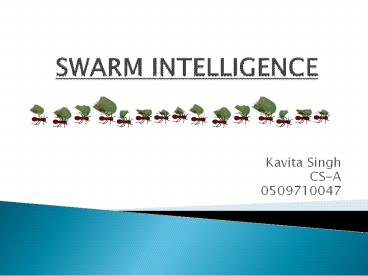SWARM INTELLIGENCE - PowerPoint PPT Presentation
Title:
SWARM INTELLIGENCE
Description:
Kavita Singh CS-A 0509710047 The economy is an example of SI that most researchers forget to consider. SI demonstrates complex behavior that arises from simple ... – PowerPoint PPT presentation
Number of Views:455
Avg rating:3.0/5.0
Title: SWARM INTELLIGENCE
1
SWARM INTELLIGENCE
- Kavita Singh
- CS-A
- 0509710047
2
Introduction
- What is Swarm Intelligence (SI)?
- The emergent collective intelligence of
groups of simple agents.
3
Examples
- group foraging of social insects
- cooperative transportation
- division of labour
- nest-building of social insects
- collective sorting and clustering
4
HISTORY
5
Why do we need new computing techniques?
- The computer revolution changed human societies
- Communication
- Transportation
- Industrial production
- Administration, writing and bookkeeping
- Technological advances
- Entertainment
- However, some problems cannot be tackled with
traditional hardware and software!
6
Drawbacks of traditional techniques
- Computing tasks have to be -
- Well-defined
- Fairly predictable
- Computable in reasonable time with serial
computers.
7
Hard problems
- Well-defined, but computational hard problems
- NP hard problems (Travelling Salesman Problem)
- Action-response planning (Chess playing)
8
(No Transcript)
9
What are the alternatives?
- DNA based computing (chemical computation) is
inspired by the human evolution. - Artificial neural network is a simplified model
of human brain. - Bio-computing(simulation of biological
mechanisms).
10
(No Transcript)
11
(No Transcript)
12
(No Transcript)
13
Working
14
Two principles of Swarm Intelligence
- 1. Self-Organization is based on-
- Positive feedback(amplification)
- Negative feedback (for balancing)
- Amplification of fluctuations(random walks,
errors) - Multiple interactions
- 2. Stigmergy-
- Indirect communication via interaction with
environment.
15
(No Transcript)
16
Pheromone Trails
- Species lay chemical substance pheromone while
travelling from nest, to nest or possibly in both
directions. - Pheromones evaporate.
- Pheromones accumulate with multiple ants using
same path.
17
The natural behavior of these ants and be
programmed into an ant algorithm, which we can
use to find the shortest path within graphs.
18
(No Transcript)
19
As ants move they leave behind a chemical
substance called pheromone, which other ants can
smell and identify that an ant has been there
before.
20
(No Transcript)
21
(No Transcript)
22
(No Transcript)
23
Why is Swarm Intelligence interesting for
IT?Analogies in IT and social insects
- distributed system of interacting autonomous
agents - goals performance optimization and robustness
- self-organized control and cooperation
(decentralized) - division of labor and distributed task allocation
- indirect interactions
24
How do we design Swarm Intelligence Systems?
- It is a 3-step process.
- Identification of analogies in swarm biology and
IT systems. - Understanding computer modeling of realistic
swarm biology. - Engineering model simplification and tuning for
IT applications.
25
Solving some of the NP-Hard Problems using Swarm
Intelligence
26
Problems
- Complex NP complete problems.
- Vehicle routing.
- Network maintenance.
- The traveling salesperson.
- Computing the shortest route between two points.
27
Failure in solving these problems
- Learning algorithms developed with artificial
intelligence systems such as neural networks
but imperfections and inefficiencies in both
the hardware and software have prevent reliable
results. - Genetic algorithms also made an attempt at these
problems, and had some success. The algorithms
were considered too complex to re-implement.
28
Scientists, now, are looking into the world of
insects in search of new methods and approaches
of attacking complex problems.
29
Travelling Salesman Problem
- Visit cities in order to make sales.
- Save on travel costs.
- Visit each city once (Hamiltonian circuit).
30
Combinatorial Explosion in Travelling Salesman
Problem
- If there are N cities, then the number of
different paths among them is 1.2(N-1). - Time to examine single path N.
- Total time to perform the search (N-1)!
- For 10 cities, time reqd. 10! 3,268,800.
31
Solution of TSP by Swarm Intelligence
- Use of agents for TSP problem.
- They sense and dispense pheromone.
- Memory to back step through the graph.
- Each agent starts at a random starting city.
- Once agent finishes a tour, it determines the
size of the tour. - Then pheromone is added to the tour, the shorter
the tour, the higher the pheromone level.
32
- No guarantee that the first tour the agents will
converge the shortest path. - Agents explore other tours.
- The stray agent finds a shorter path.
- Adjusts the pheromone levels.
- Plenty of computing time needed to converge on
the optimal tour. - The ant algorithm approach will still solve
faster than other algorithms.
33
Vehicle routing by Swarm Optimization
- Vehicle routing is similar to the TSP problem.
- Employee services the client by going to them.
- Minimize cost.
- Use the same optimal Hamiltonian circuit as in
the TSP problem.
34
Use of Swarm Intelligence in Economy
- The economy is an example of SI that most
researchers forget to consider. - SI demonstrates complex behavior that arises from
simple individual interactions. - No one can control the economy, as there are no
groups that can consistently control the economy.
35
- The reaction of the population causes the the
economy to slow down. - Simulating an economy using ant algorithms.
- Makes it possible to control or predict the ebb
and flow of this complex behavior. - Swarm intelligence, is still in its infancy.
- A project such as simulating the economy is still
far beyond the its capability.
36
Conclusion
- Scientists are realizing SIs potential.
- The use of ant algorithms within computing
systems has helped to solidify swarm
intelligences place in the computing world. - Already researchers are observing other social
animals, such as bees and schools of fish in
order to utilize it in future applications and
algorithms.
37
References
- http//www.engr.iupui.edu/eberhart/
- http//users.erols.com/cathyk/jimk.html
- http//www.alife.org/
- http//www.aridolan.com/
- http//www.red3d.com/cwr/boids/
- http//iridia.ulb.ac.be/mdorigo/ACO/ACO.html
- http//www.engr.iupui.edu/shi/Coference/psopap4.h
tml































